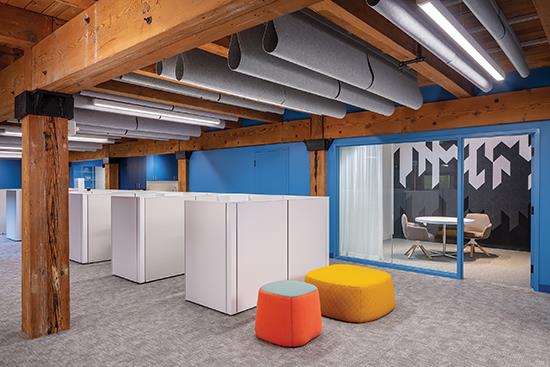The Top 250 Design Survey: The A&D community weighs in on the state of interior design and the commercial flooring business - Oct 2020
By Darius Helm
Despite daunting conditions in the market, architects and designers remain focused on providing solutions to end users, pivoting to develop innovative responses to the new range of concerns and priorities arising from the novel coronavirus crisis.
Needless to say, business has slowed. Billings are down. Budgets are down. This year, only 3% of respondents reported that budgets were up, compared to 23% last year, 37% in 2018, 38% in 2017 and 30% in 2016. Fully 50% of respondents say budgets are down; the remaining 47% say they’re flat. And the future looks just as uncertain, as the pandemic, climate change, racial protests and election-year politics create a distraction from normalcy. Many businesses are holding back and waiting for signs of stability.
Although profound impacts on the design of commercial interiors are on the way, with everything in flux, it’s too early to know how the landscape will change. The corporate sector, where hot-desking now takes on a new meaning, is still in the early stages of adapting to events. However, a recent survey by the National Bureau of Economic Research predicts that employers believe that 40% of those who switched to working remotely could effectively do so after the crisis ends.
Commercial flooring business has similarly declined in the last six months. It’s reflected in the results of public flooring firms, with second quarter declines year over year ranging from 25% to over 40%. In that same quarter, the U.S. GDP decreased at an annual rate of 31.7%. All the commercial firms are facing the same conditions, though resilient flooring seems to be faring better than the other flooring categories.
The Architecture Billings Index (ABI), which is an economic indicator of commercial construction activity nine to 12 months out, was on the rise at the beginning of the year, with a score of 52.2 in January rising to 53.4 in February (above 50 indicates growth). In March, it plummeted to 33.3, then down to 29.5 in April, uncharted territory for the ABI. The previous record low was 34.3 in January 2009.
The numbers have improved somewhat since then, rising to 32 in May and 40 in both June and July, though they are still lower than anything in the last decade. But if the trend continues, the ABI could enter positive territory before the end of the year.
For the complete Design Survey results, see the October 2020 issue of Floor Focus Magazine.
This year marks a quarter-century of Floor Focus Top 250 Design Surveys. Since the mid-1990s, Floor Focus has been reaching out to top design firms for insights into all aspects of the commercial market and its use of floorcoverings.
Over the years, some designers have opined on finding the time to respond to this comprehensive survey-in response, Floor Focus has shortened it over the years, including this year-yet the vast majority have thanked us for what we do. And, in turn, we thank the architect and design community for participating in these surveys year after year and helping the flooring industry to better understand the needs of designers and hopefully to better serve them.
Copyright 2020 Floor Focus
Related Topics:Coverings
